BY LETTER
Tien-schu
Galactography > Regions of Space > Middle Regions/Hinter-regions
Sophonts > Modosophonts > Provolve
Galactography > Systems and Worlds > Systems & Worlds S - T
Galactography > Sephirotic Empires > Zoeific Biopolity
Sophonts > Modosophonts > Provolve
Galactography > Systems and Worlds > Systems & Worlds S - T
Galactography > Sephirotic Empires > Zoeific Biopolity
System which is host to several species of provolved mouse | |
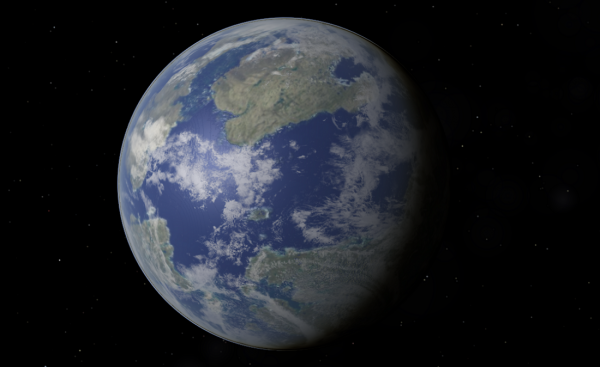 Image from Steve Bowers | |
| Tien-Schu, the first world in this system to be fully terraformed | |
The Mouse that Hides
Star HIP 112841Type G5
Luminosity 1.7 x Sol
Distance from Sol 744 ly
Constellation: Lacerta
Right ascension: 22h51m07.25s
Declination: +44°40'53.8"
Planets
Miao:Type Hermian
Diameter 14091km
SemiMajor Axis 0.11 AU
Tien-schu:
Type Gaian
Diameter 6199km
Semimajor Axis 1.4 AU
Jiuli:
Type SuperArean
Diameter 15010km
Semimajor Axis 2.3 AU
Banquan:
Type Eujovian
Diameter 50891km
Semimajor Axis 5.8 AU
In 3691 the Zoeific Biopolity seedship Shēngwù reached HIP 112841, 744 ly from Sol, in the constellation Lacerta. Unusually for the Biopolity, this seedship held a relatively limited genetic reservoir, consisting mostly of species derived from terragen grasses and other plants, and a very small number of mammals, all members of the family Muridae. The ship also carried a copy of the Biopolity transapient Lifebringer Shennong, who was believed to be searching for a world in order to carry out a new experiment in provolution, although the details of this experiment were unknown.
The most suitable world was a small lifeless terrestrial world, which the Lifebringer named Tien-schu and began to terraform; but little information filtered back to the main Biopolity worlds, and the nature of the experiment remained unclear. The system was mostly forgotten about, and during the Version War no battle fleets approached within a hundred light years of this system.
During the ComEmp era many systems which had been cut off during the conflict were recontacted; Tien-schu was isolated by choice rather than by war, but the system was visited in due course by a ComEmp recovery fleet, and the nature of Shennong's efforts were finally made clear.
Mouse Provolution
Most previous attempts at mouse provolution had been less than successful- the end result was generally very un-mouselike, and had more in common with the rat provolves that were relatively widespread throughout the Terragen Sphere. The main problem was the small size of the mouse body and brain, which made including a fully-sophont biological mind problematic. During the period of isolation, Shennong had developed a number of different solutions to this problem, resulting in a range of very different sophont mice.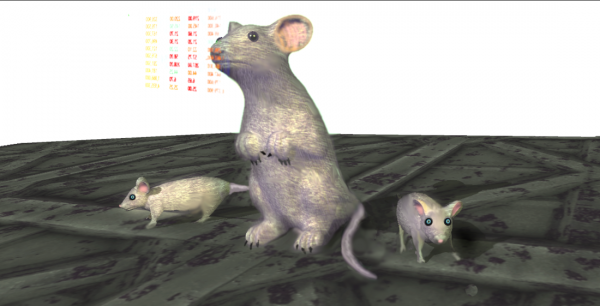 Image from Steve Bowers | |
| A mouseman and two cybermice check the stock market values | |
The Micemen
Using purely biological tech to augment individual mice to full sophonce required that the individual animals were increased in size until they could support a sufficiently large and complex brain to be self-aware and cogent. The resulting species was twenty centimetres high, often adopting a bipedal gait; and superficially resemble several long-established rat provolve species that are similarly sized, but the Tien-schu micemen have very different psychological characteristics to their distant cousins. Micemen live on the surface of the terraformed planet, cultivating enhanced cereal species which they use as food; they live in small towns or villages consisting of numerous house-like buildings that somewhat resemble human houses, but each house is mostly filled with a nest of comfortable fibrous material in which the micemen sleep. Micemen are both polygamous and polyandrous, often in different cultures at different times. For transport they use autonomous vehicles of various sorts, although most members of the community do not often travel very far. Instead they communicate using a localnet and basic-level DNI communications. Heavy lifting and construction work are performed by robot servants, often human-sized or larger.During the period of Isolation the Micemen had fought several minor battles on their world, often due to population pressure; the local transapients had found it necessary to monitor and moderate their breeding over time, to reduce the likelihood of conflict. Although the Micemen were considerably more amicable and even-tempered than their rat relatives, they were occasionally capable of violence under stress.
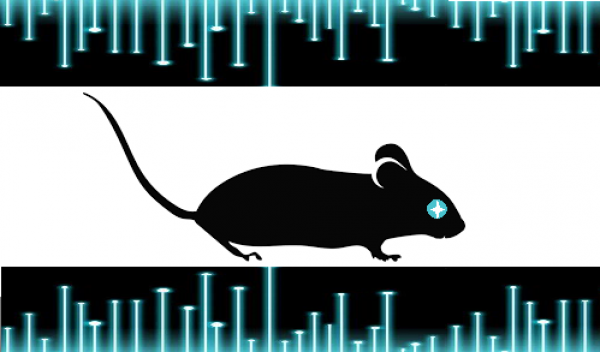 Image from MacGregor | |
| Cybermice Flag | |
Cybermice
By replacing much of the biological tissue with processing hardware, it was possible to create individual sophont-level mice which were roughly the same size as a baseline mouse. These cyborgs have artificial muscles and bones, which are much smaller in bulk than their biological counterparts; the rest of their bodies are packed out with computronium. Most cybermice retain their original biological brain, supported by a reduced biological homeostasis system; it appears that the intention behind most of Shennong's efforts was to produce sophonts in each case that were as close to the mouse baseline as possible.The resulting cybermice are very mouse-like in appearance; the same size as Mus Musculus, covered in realistic artificial fur, these augmented mice look and act the part. Some cybermice live on the fringes of Micemen towns, raiding their fields and stealing their crops; however most cybermice live in ramshackle arcologies filled with technology and facilities for manufacturing ingenious toys, which they often trade with the other provolves on this world. Cybermice and Micemen are often at loggerheads over piracy and trade disagreements, but they also form alliances readily, and a large number of mice townships are inhabited by both species.
Hive Mice
A third provolve species present in this system is the Hive Mice. By using neural interfacing and technotelepathy, it is possible to link enough mice minds together to form a gestalt that is fully sophont. However the resulting hive minds are quite unlike the individual sophont minds which the Micemen and cybermice possess, and many communication difficulties remain. Hive mice often act like a mouse swarm, over-running an area of crops or other foodplants and leaving little behind; for this reason they were initially segregated by the local planetary controllers into separate regions of the planet, where the hive mice could develop a suitable way of managing their own food supplies without inconveniencing any other populations.However the hive minds of the mice swarms are very smart, often more intelligent than individual Micemen or cybermice, so they were capable of developing strategies of their own that allowed the hives to interact more closely with the individually sophont population. A number of hivemind enclaves have been permitted to develop among the other species, and these live in relative harmony with their neighbours.
Hypermice
The last variant of sophont mouse found on this world is the Hypermouse; this is a very small population of apparently quite ordinary mice that behave largely like baseline mice, but each mouse is linked via comprehensive neural interfacing to a Biopolity hyperturing. The mouse/hyperturing pair is exclusive and all-encompassing; each hyperturing is only linked to one mouse, and vice-versa, and everything the mouse experiences is experienced by the hyperturing. On the other hand the hyperturing can assume complete control of the mouse whenever necessary, and often does, and all communication from the hyperturing itself to the outside world is channelled through the mouse, except where bandwidth limitations dictates otherwise.This quite unusual arrangement has been studied by toposophologists for many millenia, and it seems that the hyperturing is intimately integrated with the mouse, and even dependent on the mouse for its personal sense of identity. Some suggest that the mouse mind, as basic as it is, acts as a data generator for the much greater mind of the hyperturing, and literally gives the hyperturing its perspective on the world. No more than sixty hypermice have been active on Tien Schu at any one time, and all have been S:1 entities. The organic component of each hypermouse is very long-lived, but not immortal, and when the mouse body dies, the rest of that entity seemingly withdraws from interaction with modosophont culture.
The Micemen/Hivemice conflicts
Even before Tien-Schu was recontacted, tensions between hivemice and micemen were considerable. Micemen culture resembled human culture in some ways; each mouseman was an individual, and often self-interest was the driving force behind much of eir actions. A mouseman town consisted of numerous small, privately-own homes, each with a small number of inhabitants, arranged along narrow covered streets along which the micemen would scamper furtively. Each mouseman would maintain a store of foodstuffs, either obtained from agricultural factors as part of a metric-determined post-scarcity economy, or home-grown in small plots just outside the town.The world of Tien-schu includes several large islands and small continents, and several different cultural traditions had arisen on these land-masses among the micemen; but most of these cultures included some sense of personal property and a desire to maintain a store of consumables for future use. On then other hand, the hive-mice were much less aware of the concept of individual property, and when travelling in a swarm the hivemice were prone to damaging and consuming the crops and other goods of the mousemen. Where possible the hivemice swarms would compensate the mousemen villages for such losses, often by assisting them with various tasks; but over time the mousemen enclosed an increasing amount of land for their activities, making it more difficult for the swarms to continue with their scavenging lifestyle.
This contrast in strategy led to an increasing antagonism between the micemen and the swarms, and by the Age of Re-Evaluation the Hivemice minds were concentrating their efforts in establishing separate territories for themselves where they could continue their activities without inconveniencing others. To many micemen, hivemouse mentality seemed aloof and dissociated from reality, and there was great difficulty in finding common ground. In many cases interactions between the two clades were helped by mediators from the cybermouse clade, who were capable of adjusting their psychological outlook using dedicated psychoware. In the worst cases a hypermouse mediator might be required.
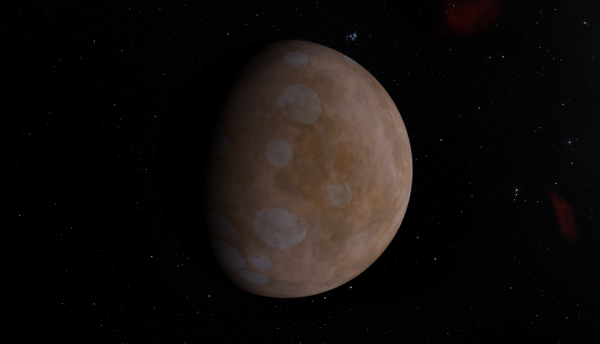 Image from Steve Bowers | |
| Jiuli, a large Mars-like planet, before terraforming | |
Jiuli is terraformed
But even moving to separate territories did not solve all the conflicts- often there were populations of micemen (and/or cybermice) on these islands, and disputes arose for various reasons. Eventually, in 6029AT a number of swarms pooled their resources and established a colony on the outer world Jiuli, which was a dry, inhospitable superarean world. The process of terraforming Jiuli was a challenging one, as it required a considerable influx of volatiles; but by 7000AT this was practically complete. The gravity on Jiuli is quite high, more than 1.8 gees, but the small, quadruped hivemice have become adapted to this environment with only minimal tweaking. The surface is now largely covered with modified wildplants that are an easy source of sustenance for the swarms as they pursue their collective dreams.The Miao Cybernode
During this period the Tien-Schu cybermice established a colony on the hot, rocky inner world of Miao, creating a warren-like city among banks of processors and power-collectors. In the Current Era most of the population of cybermice live on this world, as do many of the system's hypermice and a respectable population of micemen. However Tien-Schu remains the most populous world in the system, with considerable numbers of cybermice and micemen, as well as a number of relatively well-behaved swarms.After the transapient Shennong left the system at the start of the Age of Separate Empires and departed towards the Periphery, the hypermice have become the de-facto rulers and caretakers of the Tien-Schu system, and have largely been successful in reducing conflicts between the disparate rodents. A moderately large number of provolved mice have left this system to establish colonies elsewhere in the Terragen Sphere, not just in the Zoeific Biopolity but throughout the Outer Volumes and Periphery. Some of these new colonies have developed in unique and idiosyncratic ways, such as the Mice-king cultures of Hoffman in the Aquila outer regions.
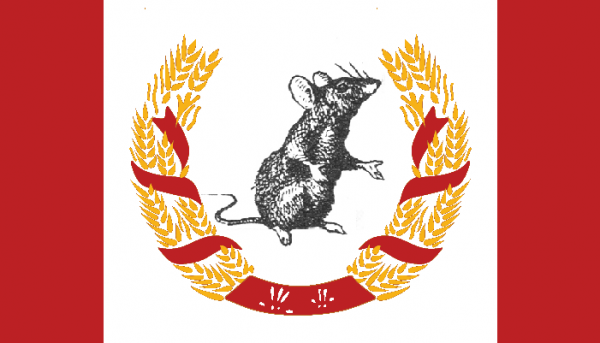 Image from MacGregor | |
| Mouseman Flag | |
Related Articles
- Hive Mind
- Raffin
- Rat - Text by M. Alan Kazlev
Any of several species of adaptable, intelligent terragen rodent. All through history rats have proved adaptable and were one of the few types of animals to thrive with the ascendence of baseline hu. Easily kept and bred, they are popular with geneers and spacers, and it is estimated that several million species have been created, hybridized, or have evolved naturally, in the period since mindkind first ventured into space. Rat splices, rat tweaks, and ratborgs have proved their worth on ships, especially relativistic and pioneer vessels, many time, and often develop into unique and indigenous ecosystems. Rat provolves are also common, although not as common as cat or dog provolves. - Rat Provolves
- Rodent
Appears in Topics
Development Notes
Text by Steve Bowers
Initially published on 02 April 2019.
Initially published on 02 April 2019.






